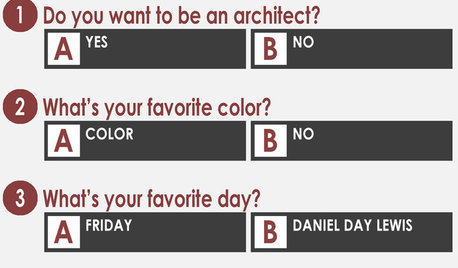A simple math question
User
12 years ago
Related Stories

COFFEE WITH AN ARCHITECTA Quiz for Architects in Question
Should you trade in your T-square for a barista tray? Answer a few simple questions to find out
Full Story
SELLING YOUR HOUSE15 Questions to Ask When Interviewing a Real Estate Agent
Here’s what you should find out before selecting an agent to sell your home
Full Story
FEEL-GOOD HOMEThe Question That Can Make You Love Your Home More
Change your relationship with your house for the better by focusing on the answer to something designers often ask
Full Story
KITCHEN DESIGN9 Questions to Ask When Planning a Kitchen Pantry
Avoid blunders and get the storage space and layout you need by asking these questions before you begin
Full Story
MOST POPULAR8 Questions to Ask Yourself Before Meeting With Your Designer
Thinking in advance about how you use your space will get your first design consultation off to its best start
Full Story
REMODELING GUIDES9 Hard Questions to Ask When Shopping for Stone
Learn all about stone sizes, cracks, color issues and more so problems don't chip away at your design happiness later
Full Story
5 Questions for Design Stars
Add Your Ideas for Outdoor Storage, Cheering Up a Fireplace and More
Full Story
MOVINGHiring a Home Inspector? Ask These 10 Questions
How to make sure the pro who performs your home inspection is properly qualified and insured, so you can protect your big investment
Full Story
WORKING WITH PROS10 Questions to Ask Potential Contractors
Ensure the right fit by interviewing general contractors about topics that go beyond the basics
Full Story
REMODELING GUIDESSurvive Your Home Remodel: 11 Must-Ask Questions
Plan ahead to keep minor hassles from turning into major headaches during an extensive renovation
Full Story



sjerin
azzalea
Related Discussions
Math Question Dilution
Q
container size - math question
Q
I forget the explanation to this math question
Q
math question
Q
sjerin
camp56
mimi_boo
joyfulguy
mawheel
suzieque
jannie
UserOriginal Author
suzieque
bigfoot_liz
cynic
Tally
UserOriginal Author
LuAnn_in_PA
hayjud_mn
Tally
Tally
UserOriginal Author
jemdandy
Tally
hayjud_mn
kudzu9
cynic
zeetera
golfergrrl
cynic
hayjud_mn
susan_on
golfergrrl
kudzu9
susan_on
zeetera
suzieque
golfergrrl
jemdandy
gemini40
titanchemical
katlan
Tally